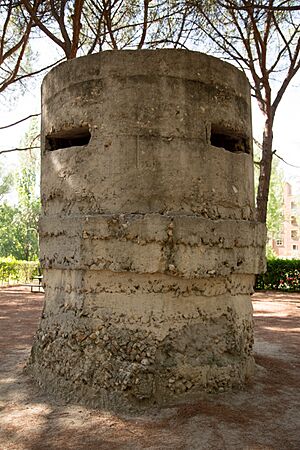Parque del Oeste facts for kids
Quick facts for kids Parque del Oeste |
|
|---|---|

Fountain of Juan de Villanueva.
|
|
| Lua error in Module:Location_map at line 420: attempt to index field 'wikibase' (a nil value). | |
| Location | between the Autovía A-6, the Ciudad Universitaria de Madrid and the district of Moncloa, Madrid |
| Created | 1893 |
| Status | Opened all year |
The Parque del Oeste (which means Western Park in English) is a beautiful park located in the city of Madrid, Spain. You can find it between a main road called Autovía A-6, the University City, and the Moncloa area.
Before it became a park, this land was actually the city's main landfill, a place where all the trash was taken! But thanks to Alberto Aguilera, who was the mayor of Madrid in the early 1900s, it was transformed. In 1906, he asked a landscape artist named Celedonio Rodrígáñez to design a lovely spot for people to walk and relax.
Today, the park has many cool features. One of the most famous is its amazing rose garden, where a special rose competition is held every year.
One of the park's most unique attractions is the Temple of Debod. This is an ancient Egyptian temple that was given to Spain by Egypt in 1968. It was a thank-you gift because Spain helped save other important temples, like the Abu Simbel temples, from being flooded.
You can also ride the Teleférico de Madrid, which is a gondola lift (like a cable car). It connects the Parque del Oeste to another big park called Casa de Campo. It's a fun way to see the city from above!
Contents
Park History: From Landfill to Green Space
The work to create Parque del Oeste began way back in 1893. The first part of the park opened in 1905. This first section covered about 87 hectares (that's like 215 acres!) and included areas that are now the streets of Moret and Seneca, plus a car ride called Paseo de Camoes.
In 1906, they started working on the second part of the park. This section stretched all the way to the Cuartel de la Montaña, which is where the Temple of Debod stands today. This new part of the park was built on old dump sites, right next to the Paseo del Pintor Rosales.
The Park During the Spanish Civil War

During the Spanish Civil War (1936-1939), Parque del Oeste became a battlefield. It was a very important location during the Battle of Ciudad Universitaria. Soldiers dug trenches and built bunkers here. You can still see some of these old bunkers at the northern end of the park today! The southern part of the park was also where the siege of the Montaña barracks happened in July 1936. The barracks are not there anymore.
Rebuilding and Expanding the Park
After the war ended, a person named D. Cecilio Rodriguez, who was in charge of Madrid's parks, helped rebuild Parque del Oeste. This reconstruction work lasted until the late 1940s. They made sure to keep the park's original look, its types of plants, and the way its paths were laid out.
Later, between 1956 and 1973, the park was made even bigger. It expanded onto the land where the Cuartel de la Montaña used to be. This is when the beautiful Rose Garden and the Parque de la Montaña (where the Temple of Debod is located) were built.
See also
 In Spanish: Parque del Oeste (Madrid) para niños
In Spanish: Parque del Oeste (Madrid) para niños

